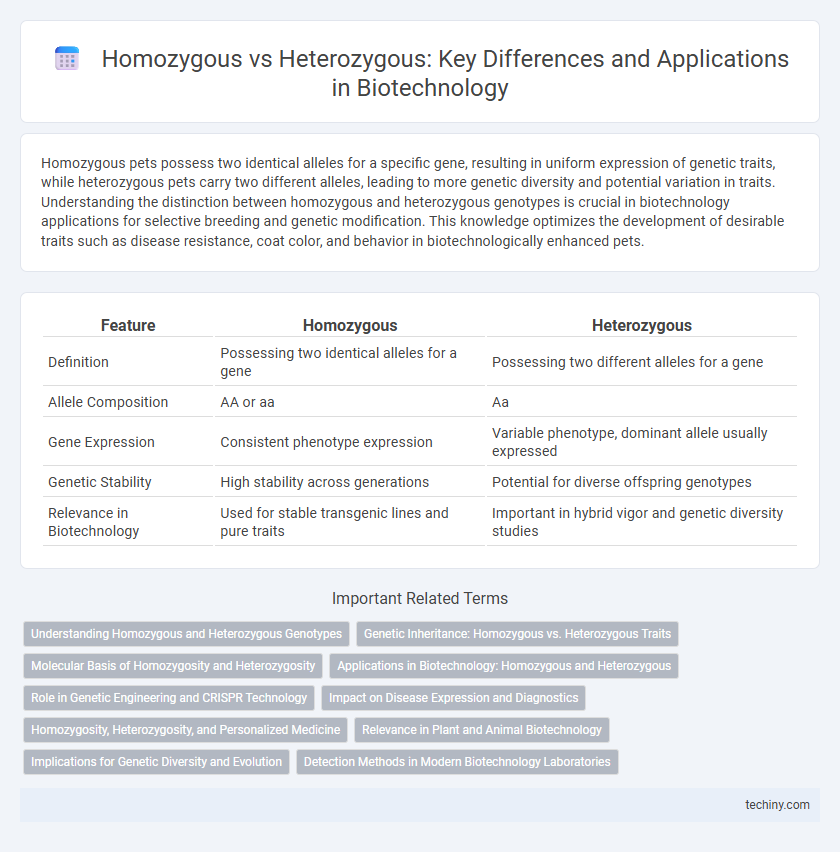Homozygous pets possess two identical alleles for a specific gene, resulting in uniform expression of genetic traits, while heterozygous pets carry two different alleles, leading to more genetic diversity and potential variation in traits. Understanding the distinction between homozygous and heterozygous genotypes is crucial in biotechnology applications for selective breeding and genetic modification. This knowledge optimizes the development of desirable traits such as disease resistance, coat color, and behavior in biotechnologically enhanced pets.
Table of Comparison
| Feature | Homozygous | Heterozygous |
|---|---|---|
| Definition | Possessing two identical alleles for a gene | Possessing two different alleles for a gene |
| Allele Composition | AA or aa | Aa |
| Gene Expression | Consistent phenotype expression | Variable phenotype, dominant allele usually expressed |
| Genetic Stability | High stability across generations | Potential for diverse offspring genotypes |
| Relevance in Biotechnology | Used for stable transgenic lines and pure traits | Important in hybrid vigor and genetic diversity studies |
Understanding Homozygous and Heterozygous Genotypes
Homozygous genotypes occur when an organism inherits identical alleles for a specific gene from both parents, resulting in uniform expression of a trait. Heterozygous genotypes involve two different alleles, leading to varied phenotypic outcomes depending on dominance relationships. Understanding these genotypic variations is essential for genetic mapping, disease prediction, and biotechnological applications such as gene editing and selective breeding.
Genetic Inheritance: Homozygous vs. Heterozygous Traits
Homozygous individuals possess two identical alleles for a specific gene, resulting in the expression of a uniform genetic trait, while heterozygous individuals carry two different alleles, leading to potential dominance or recessiveness in trait manifestation. Genetic inheritance patterns depend on the combination of these alleles, influencing phenotypic outcomes and hereditary disease risks. Understanding homozygous versus heterozygous genotypes is crucial for predicting trait transmission and for applications in genetic engineering and breeding programs.
Molecular Basis of Homozygosity and Heterozygosity
Homozygosity occurs when an organism inherits two identical alleles of a gene, leading to uniform expression of that genetic trait at the molecular level due to the presence of the same DNA sequence on both homologous chromosomes. Heterozygosity arises from inheriting two different alleles for a gene, resulting in a combination of variant nucleotide sequences that can produce diverse protein products or dominant-recessive interactions. The molecular basis of homozygosity and heterozygosity influences gene expression patterns, protein function, and phenotypic variability critical for genetic diversity and disease susceptibility studies in biotechnology.
Applications in Biotechnology: Homozygous and Heterozygous
Homozygous organisms, containing identical alleles for a specific gene, enable consistent expression of desired traits, which is crucial for developing genetically stable crop varieties and pharmaceuticals. Heterozygous individuals, possessing two different alleles, provide genetic diversity that is exploited in hybrid vigor to enhance yield and stress resistance in biotechnology applications. Techniques such as CRISPR gene editing leverage the distinction between homozygous and heterozygous genotypes to achieve precise genetic modifications for improved biotechnological outcomes.
Role in Genetic Engineering and CRISPR Technology
Homozygous and heterozygous genetic states play crucial roles in genetic engineering and CRISPR technology, influencing gene editing outcomes and phenotypic expression. Homozygous organisms, with identical alleles at a specific locus, allow for stable inheritance of edited traits, while heterozygous organisms present opportunities to study allele-specific editing effects and mosaicism. CRISPR-Cas9 systems leverage these zygosity differences to achieve precise gene modifications, enabling targeted therapies and functional genomics research.
Impact on Disease Expression and Diagnostics
Homozygous genetic mutations often result in more severe disease phenotypes due to the presence of identical alleles that can exacerbate functional impairments in proteins, whereas heterozygous mutations may lead to milder symptoms or carrier states depending on the gene's mode of inheritance. In diagnostics, identifying homozygous mutations allows for definitive disease confirmation and prognosis assessment, while detecting heterozygous variants is crucial for carrier screening and risk evaluation in autosomal recessive disorders. Advanced molecular techniques such as next-generation sequencing (NGS) enhance the precision of distinguishing homozygous from heterozygous genotypes, thus improving personalized treatment strategies and genetic counseling.
Homozygosity, Heterozygosity, and Personalized Medicine
Homozygosity refers to the presence of identical alleles at a specific gene locus, while heterozygosity indicates different alleles at that locus, influencing genetic variation and disease susceptibility. High levels of heterozygosity often enhance genetic diversity, which can affect individual responses to drugs and therapeutic interventions. Personalized medicine leverages the understanding of homozygous and heterozygous genetic profiles to tailor treatments based on an individual's unique genetic makeup, improving efficacy and reducing adverse effects.
Relevance in Plant and Animal Biotechnology
Homozygous and heterozygous genetic states are crucial in plant and animal biotechnology for trait inheritance and hybrid vigor. Homozygous plants or animals possess identical alleles for a trait, ensuring uniformity in genetically engineered crops and breeds. Heterozygous genotypes contribute to genetic diversity and heterosis, enhancing disease resistance and productivity in biotechnological breeding programs.
Implications for Genetic Diversity and Evolution
Homozygous individuals possess identical alleles at a gene locus, reducing genetic variation within populations, whereas heterozygous individuals carry different alleles, promoting genetic diversity that enhances adaptive potential. Increased heterozygosity contributes to evolutionary fitness by enabling populations to better withstand environmental pressures and resist disease. Maintaining a balance between homozygosity and heterozygosity is critical for conserving genetic resources and facilitating long-term species survival.
Detection Methods in Modern Biotechnology Laboratories
Detection methods in modern biotechnology laboratories for distinguishing homozygous and heterozygous genotypes primarily involve PCR-based techniques, such as allele-specific PCR and quantitative real-time PCR, which amplify and quantify target DNA sequences with high precision. Next-generation sequencing (NGS) offers comprehensive analysis by providing detailed insights into genetic variations at the nucleotide level, enabling accurate identification of zygosity status. Additionally, CRISPR-based diagnostics and digital droplet PCR (ddPCR) enhance sensitivity and specificity, facilitating rapid and reliable genotyping essential for research and clinical applications.
Homozygous vs Heterozygous Infographic

 techiny.com
techiny.com